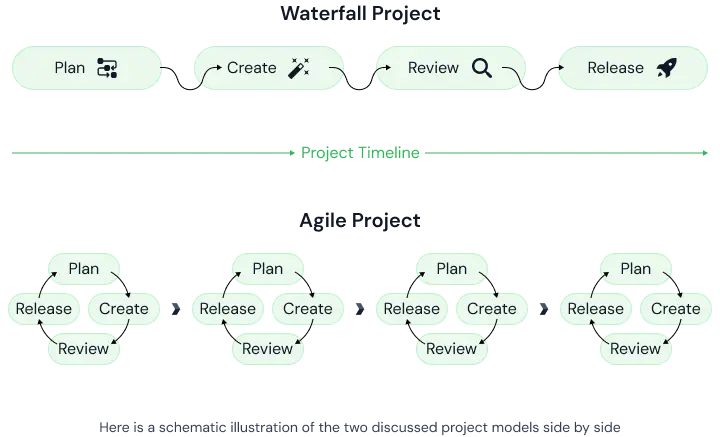Introduction
When it comes to custom software development, selecting the right software model is just as critical as selecting the right vendor. Why is the model so important? A wise man once said that if you fail to plan, you plan to fail, and the Systems Development Life Cycle (SDLC) model is a critical component in planning a project.
The SDLC is a conceptual framework that outlines all the activities in software development. In other words, it's the key planning tool that will guide your developers step by step through the project.
You need a model that can maintain all the business requirements, ensure every feature is designed and built properly, and ensure the project operates as it should.
So what are the options, and what kind do you need? Generally speaking, the various SDLC models fall into two major groups: predictive and adaptive.
Both approaches are equally valid, and it's the project type that should drive the model selection. The choice will depend on evaluation of all the pros and cons of each model in the context of the particular project's goals and constraints.

The predictive development model
Predictive, or incremental development, is a software development methodology where the model is designed, implemented, and tested incrementally (piece by piece) until the product is finished, or until all the requirements have been satisfied.
This model combines the elements of the waterfall model with the iterative philosophy of prototyping. In this model, each module passes through the requirements, design, implementation, and testing phases.
As this model involves delivering system components as they're completed, it allows for partial utilization of product, meaning completed features can be used before the full project is finished and avoids a long development time. That means this model helps ease the traumatic effect of introducing a completely new system all at once.
Pros of the predictive model
- the predictive model generates a working software product quicker than the adaptive model.
- it's easier to manage risk with this model because potential obstacles are identified and handled during their first iterations.
- it is easier to test and debug during iterations of smaller pieces than on the full product.
- this model allows for more flexibility, as changes to scope and requirements may be made to every increment.
Cons of the predictive model
- this model requires good planning and design. If tasks aren't done properly in each phase, the entire project can be impacted.
- a clear and complete definition of the whole system is required before it can be broken down and built incrementally.
- additional efforts are required to integrate each individual component of the system.
When to use the predictive model
So, how do you know if the predictive development approach is right for your product? Here are a few of the biggest signs:
- the requirements of the software are clear and can be implemented in logical phases, even though some details may evolve with time.
- the product includes some high-risk features and goals.
- the development plan calls for new technology.
- your business needs clarity on and strict adherence to a timeline based on the agreed-upon scope.
The adaptive development model
Adaptive life cycles like SCRUM or Kanban (also known as agile or change-driven approaches) are designed to iterate rapidly on projects that are a little more experimental or less certain.
These models are dependent on ongoing contributions from all stakeholders, and they react quickly to the changes in project scope and system requirements. This approach is sometimes referred to as ‘freeform software design’ as it offers an incredibly flexible design model, promoting adaptive planning and evolutionary development when the end goal is not quite as concrete.
At Syberry we deploy cross-functional teams to take an agile approach to the majority of our projects. This approach entails short sprints with frequent product demo sessions that allow flexibility and prompt adjustments during any phase of the development process, reducing the risk of wasted costs, even when we're moving fast.
Daily scrum meetings are intended to track progress and proactively react to changing conditions. With this approach, too, product owners and managers are closely involved in the development process, eventually becoming a part of a team to allow real collaboration between our developers and our clients.
Pros of the adaptive model
- this model allows for evolving requirements so change can be implemented very easily given the shorter planning cycles (sprints).
- this model encourages customer satisfaction through fast and continuous delivery.
- adaptive development encourages active involvement and interaction from key project stakeholders, which allows for product build based on priority and accuracy.
Cons of the adaptive model
- planning can be dubious.
- team members must be highly skilled and cross-skilled as core teams are small.
- the project can easily get thrown off track if the customer is not clear on the desired final outcome.
When to use the adaptive model
Given all of this, what are some indicators that your project would benefit from an adaptive development approach?
- the end goals of projects are not clearly defined.
- it's important to begin the implementation process quickly. (For large and dynamic projects with evolving requirements, it makes no sense to belabor the process of predefining requirements in minute detail).
- the project calls for experimental software design.
Difference between predictive and adaptive development
When you get down to brass tacks, the difference between the two approaches is that the adaptive approach enables more flexibility and makes more room for change throughout the development process. While the predictive model is more appropriate for a project with a definite vision and set of specs that aren't likely to change midstream.
To see the difference in action, consider this chart that shows the two processes side-by-side. The predictive development process is more or less linear, planning, creating, reviewing, and releasing each component in one fell swoop.
The agile approach is iterative, spiraling through shorter cycles that start with a complete but bare-bones product and layer on features, functionality, and complexity throughout the process.
If you're looking for a trusted partner to drive your next custom software development project forward, contact Syberry and tell us about your business goals.



